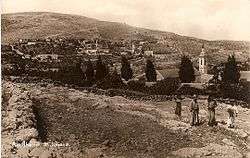
Ayn Karim
'Ayn Karim (Arabic: عين كارم) was a Palestinian Arab town in the Mandatory Palestine's Jerusalem Subdistrict.
History
The 1947 United Nations Partition Plan for Palestine placed 'Ayn Karim in the Jerusalem enclave intended for international control. In February 1948 the village's 300 guerilla fighters were reinforced by a well-armed Arab Liberation Army force of mainly Syrian fighters, and on March 10 a substantial Iraqi detachment arrived in the village, followed within days by some 160 Egyptian fighters. On March 19, the villagers joined their foreign guests in attacking a Jewish convoy on the Tel Aviv-Jerusalem road. Immediately after the April 1948 massacre at the nearby village of Deir Yassin (2 km to the north), most of the women and children in the village were evacuated. It was attacked by Israeli forces during the ten-day campaign of July 1948. The remaining civilian inhabitants fled on July 10-11. The Arab Liberation Army forces who had camped in the village left on July 14-16 after Jewish forces captured two dominating hilltops, Khirbet Beit Mazmil and Khirbet al Hamama, and shelled the village. During its last days, 'Ayn Karim suffered from severe food shortages.

Ein Karem
Coordinates: 31°45′55″N 35°8′58″E / 31.76528°N 35.14944°E / 31.76528; 35.14944
Ein Karem (Hebrew: עַיִן כרֶם, lit. “Spring of the Vineyard”, and Arabic: عين كارم - ‘Ein Kārem or ′Ayn Karim) (also Ain Karem) is an ancient village of the Jerusalem District and now a neighbourhood in southwest Jerusalem. It was depopulated during the 1948 Arab-Israeli War on July 16, 1948.
According to Christian tradition, John the Baptist was born in Ein Karem, leading to the establishment of many churches and monasteries. In 2010 the neighborhood had a population of 2,000. It attracts three million visitors a year, one-third of them pilgrims from around the world.
History
Antiquity
A spring that provides water to the village of Ein Karem stimulated settlement there from an early time. Pottery has been found nearby dating to the Middle Bronze Age. For the Israelite age it could be identified as the location of Beth HaKerem (Jeremiah 6:1; Nehemiah 3:14), where the traditional name comes from. A reservoir here was mentioned in the copper scroll. A well-preserved mikveh, or Jewish ritual bath, indicates there was a Jewish settlement in the Second Temple period along with some other discoveries such as handful of graves, bits of a wall, an olive press and another suspected mikveh under the Church of St. John the Baptist. It was recorded during the Islamic conquest and again, under the name St. Jeehan de Bois, during the Crusades. Ottoman tax registers from 1596 showed a population of 29 Muslim families.
Podcasts:

